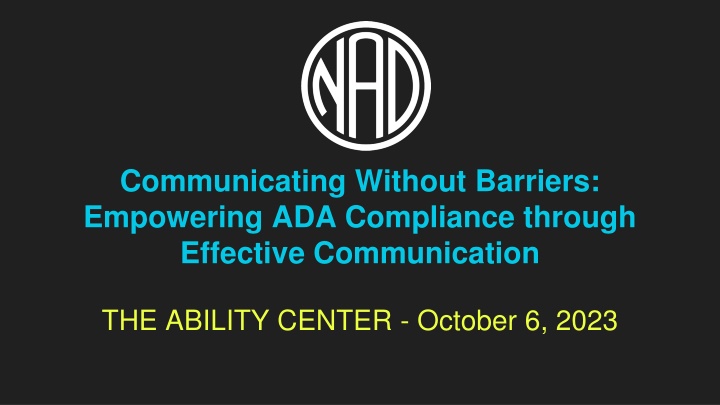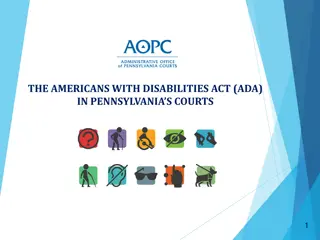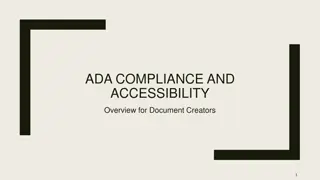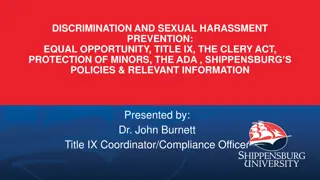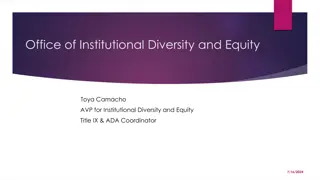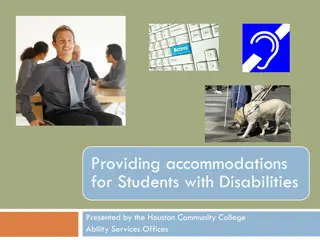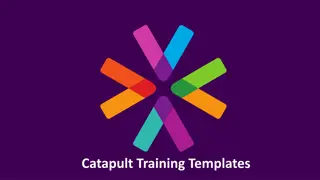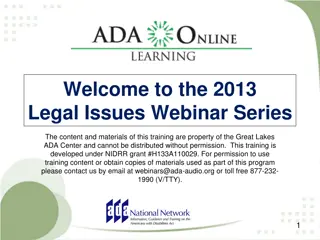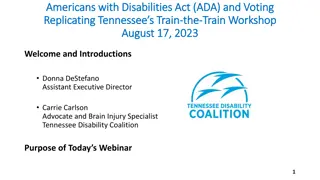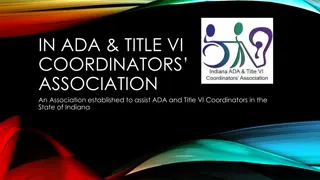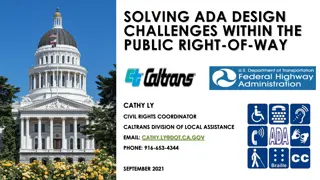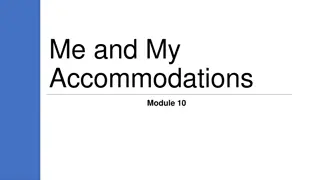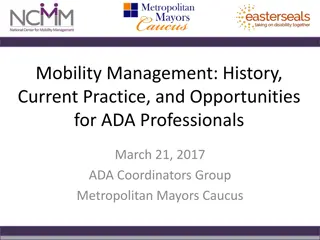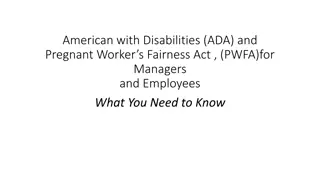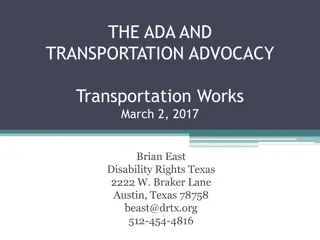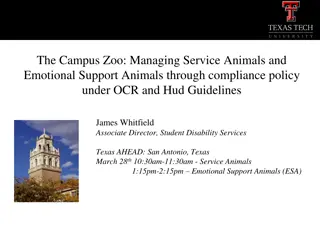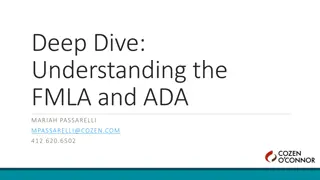Empowering ADA Compliance through Communication
This content discusses the importance of effective communication in empowering ADA compliance. It covers the mission of the National Association of the Deaf (NAD), laws mandating effective communication, and the significance of Acts like the Rehabilitation Act of 1973 and the Americans with Disabilities Act. It emphasizes the provision of auxiliary aids and services for individuals with disabilities to ensure inclusivity and accessibility.
Download Presentation

Please find below an Image/Link to download the presentation.
The content on the website is provided AS IS for your information and personal use only. It may not be sold, licensed, or shared on other websites without obtaining consent from the author.If you encounter any issues during the download, it is possible that the publisher has removed the file from their server.
You are allowed to download the files provided on this website for personal or commercial use, subject to the condition that they are used lawfully. All files are the property of their respective owners.
The content on the website is provided AS IS for your information and personal use only. It may not be sold, licensed, or shared on other websites without obtaining consent from the author.
E N D
Presentation Transcript
Communicating Without Barriers: Empowering ADA Compliance through Effective Communication THE ABILITY CENTER - October 6, 2023
NATIONAL ASSOCIATION OF THE DEAF (NAD) Established in 1880 by Deaf leaders Oldest national civil rights organization Continuously operated by Deaf leaders Mission: To preserve, protect, and promote the civil, human, and linguistic rights of all Deaf, DeafBlind, DeafDisabled, Hard of Hearing, and Late-Deafened people in the United States of America.
My Work Before and At the NAD 19 years of disability discrimination litigation in Chicago 12 years with NAD Several landmark cases Also focus on legislative, policy, and advocacy approaches
Laws Mandating Effective Communication Rehabilitation Act of 1973 (Section 504) Americans with Disabilities Act of 1990 (ADA) Affordable Care Act of 2010 (ACA) Communication & Video Accessibility Act of 2010 (CVAA)
Rehabilitation Act of 1973 First Federal Law in US (and world) mandating equal rights for people with disabilities No otherwise qualified individual with a disability in the United States shall, solely by reason of his or her disability, be excluded from the participation in, be denied the benefits of, or be subjected to discrimination under any program or activity receiving Federal financial assistance or under any program or activity conducted by any Executive agency
Americans with Disabilities Act Title I = Employment Title II = Public Entities (State & Local) Title III = Public Accommodations Title IV = Telecommunications
ADA - Auxiliary Aids and Services (1) Qualified interpreters on-site or through video remote interpreting (VRI) services; notetakers; real-time computer-aided transcription services; written materials; exchange of written notes; telephone handset amplifiers; assistive listening devices; assistive listening systems; telephones compatible with hearing aids; closed caption decoders; open and closed captioning, including real-time captioning; voice, text, and video-based telecommunications products and systems, including text telephones (TTYs), videophones, and captioned telephones, or equally effective telecommunications devices; videotext displays; accessible electronic and information technology; or other effective methods of making aurally delivered information available to individuals who are deaf or hard of hearing;
ADA - Auxiliary Aids and Services (2) Qualified readers; taped texts; audio recordings; Brailled materials and displays; screen reader software; magnification software; optical readers; secondary auditory programs (SAP); large print materials; accessible electronic and information technology; or other effective methods of making visually delivered materials available to individuals who are blind or have low vision; (3) Acquisition or modification of equipment or devices; and (4) Other similar services and actions.
ADA - Title II - Effective Communication Title II: (1) A public entity shall furnish appropriate auxiliary aids and services where necessary to afford qualified individuals with disabilities, including applicants, participants, companions, and members of the public, an equal opportunity to participate in, and enjoy the benefits of, a service, program, or activity of a public entity. (2) The type of auxiliary aid or service necessary to ensure effective communication will vary in accordance with the method of communication used by the individual; the nature, length, and complexity of the communication involved; and the context in which the communication is taking place. In determining what types of auxiliary aids and services are necessary, a public entity shall give primary consideration to the requests of individuals with disabilities. In order to be effective, auxiliary aids and services must be provided in accessible formats, in a timely manner, and in such a way as to protect the privacy and independence of the individual with a disability.
ADA - Title III - Effective Communication Title III: A public accommodation shall furnish appropriate auxiliary aids and services where necessary to ensure effective communication with individuals with disabilities. This includes an obligation to provide effective communication to companions who are individuals with disabilities. The type of auxiliary aid or service necessary to ensure effective communication will vary in accordance with the method of communication used by the individual; the nature, length, and complexity of the communication involved; and the context in which the communication is taking place. A public accommodation should consult with individuals with disabilities whenever possible to determine what type of auxiliary aid is needed to ensure effective communication, but the ultimate decision as to what measures to take rests with the public accommodation, provided that the method chosen results in effective communication. In order to be effective, auxiliary aids and services must be provided in accessible formats, in a timely manner, and in such a way as to protect the privacy and independence of the individual with a disability.
ACA - Section 1557 - Effective Comm Any entity operating or administering a program or activity under this part shall take appropriate steps to ensure that communications with individuals with disabilities are as effective as communications with others in such programs or activities A recipient or State Exchange shall provide appropriate auxiliary aids and services, including interpreters and information in alternate formats, to individuals with impaired sensory, manual, or speaking skills, where necessary to afford such persons an equal opportunity to benefit from the service in question.
ACA - Section 1557 - Auxiliary Aids & Services Interpreters on-site or through video remote interpreting (VRI) services; note takers; real- time computer-aided transcription services; written materials; exchange of written notes; telephone handset amplifiers; assistive listening devices; assistive listening systems; telephones compatible with hearing aids; closed caption decoders; open and closed captioning, including real-time captioning; voice, text, and video-based telecommunication products and systems, text telephones (TTYs), videophones, and captioned telephones, or equally effective telecommunications devices; videotext displays; accessible information and communication technology; or other effective methods of making aurally delivered information available to individuals who are deaf or hard of hearing; and Readers; taped texts; audio recordings; Braille materials and displays; screen reader software; magnification software; optical readers; secondary auditory programs; large print materials; accessible information and communication technology; or other effective methods of making visually delivered materials available to individuals who are blind or have low vision.
CVAA - Mandates Hearing Aid Compatibility with telephones & telecommunications Expand relay services to new technologies Accessible Advanced Communication Services & Equipment Accessible Internet Browsers via Mobile Phones Relay Services for DeafBlind Individuals Equal Access to Emergency Services Access to Video Programming shown on Internet from TV
Precedential Effective Comm Cases Many cases against hospitals/doctors for denial of interpreters or only using VRI that did not work under 504 and ADA Many cases against universities/colleges for denial of interpreters for students under 504 and ADA DOJ v. Camacho (Attorney refused interpreter) Prakel v. Indiana (Court refused interpreter) NFB v. Target (Web access for Blind) DOJ v. Wells Fargo (Relay service denial)
Precedential Effective Comm Cases NAD v. Netflix; agreements with Hulu, Vudu, Amazon (Streaming) NAD v. Harvard; NAD v. MIT (Web video for education) NFB v. Scribd; Robles v. Dominos Pizza (Web/app access - Blind) Martinez v. Cuomo; NAD v. Trump (ASL access to Govt leaders) NAD v. SiriusXM, Pandora, Stitcher (Podcast access)
